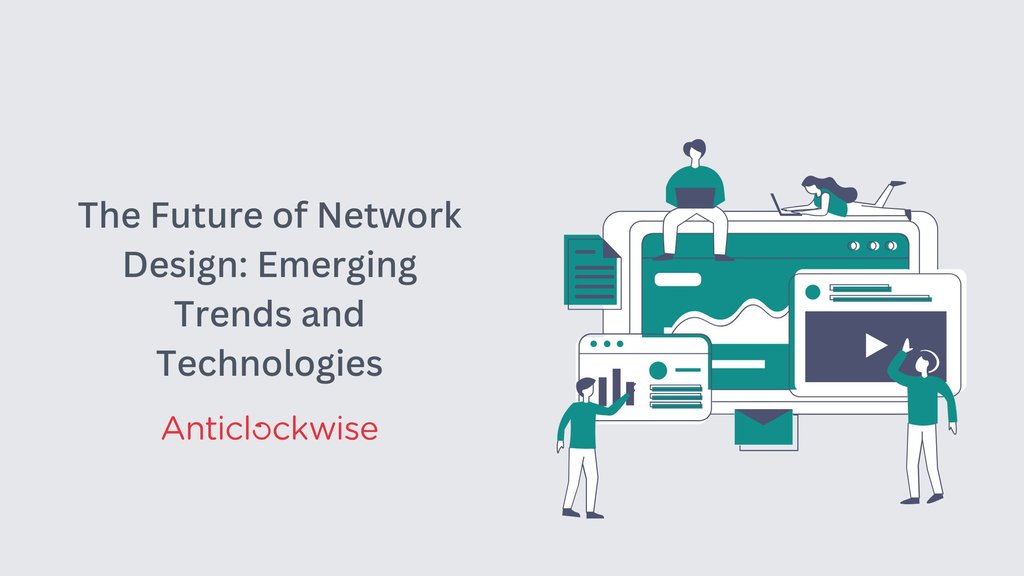
The Future of Network Design: Emerging Trends and Technologies
It is not only a technological change but also a revolution that is taking the form of major transformation disruptions in the manner by which we all connect with each other, communicate and collaborate. The very core lies in the network infrastructure that encompasses everything from smooth video streaming to industrial applications with mission-critical times.
With networks being more integrated into every aspect of modern life-from personal communication to the most crucial commercial activities-soon they will find themselves amid an increasing complexity and monstrous amounts of digital data. They will not only go up increasingly because of the large number of connected devices flooding into the marketplace but also because of the cloud, practically all services increasingly migrate into the cloud; hence, there is much increased collateral damage on networks. Thus, there's much call for resilient and agile network solutions that can change with difficult times of a world that keeps getting connected.
The Driving Forces Behind Network Evolution
The Rise of Cloud and Edge Computing
With the growth of acceptance of the cloud into business, the increase in demand for low latency connections has greatly expanded. Here is edge calculation-this design processes data far away from its source so that it is possible for very short latencies and may lessen the research of centralised cloud servers.
Cloud-native applications and microservices are the new emergence of migrated trends in creating diffused network architectures that require highly dynamic and flexible infrastructure. This architecture becomes a major factor by which a different approach can be given or the shrinking change will be possible in real-time. Edge computing goes one step ahead of distance computing by allowing transformational technologies like the IoT, AR, and even VR, which require ultra-low latency for normal functioning. As an example, to guarantee not just safety but also the efficiency of self-driving cars, they require immediate connectivity to adjacent sensors and servers.
Novel network topologies are becoming more dispersed through enterprises advance into edge computing solutions. Not only does this switch increase performance due to higher speed feeds into lower latency and fewer potential bottlenecks, but even more essential is the merit of greater reliability and paving the way toward a new era of real time data processing-invention.
The Impact of 5G and Beyond
5G technology is the most revolutionary change in connection, in terms of higher capacity, ultra-low latency, and increased connectivity density. This is the ultimate transformative platform for world's most groundbreaking applications like self-driving cars, smart cities, and enhanced mobile broadband experiences. For example, with real-time communication among the linked devices, fast sharing of data will be used, which is essential for an application.
5G with Edge brings up such advanced features in the improvements through integrating new applications like network slicing, in which a physical network can be sliced into dissimilar virtual networks depending on the requirements of each one. As an illustration, a hospital could explicitly designate low latency slices for robotic procedures while keeping other slices for administrative activities in order, hence ensuring that each use case gets the best performance.
As advancements horizontalise from today's 5G to 6G in the future, those improvements will encompass even future progressions such as the initiation of the terahertz frequency band with AI-controlled optimizations. Altogether, 5G, and its successors-to-be, will be redefining the possible in a much more connected world.
Key Emerging Technologies in Network Design
Software-Defined Networking (SDN) and Network Function Virtualization (NFV)
Traditionally, network administration has been constrained by private hardware and fixed configurations. SDN and NFV currently continue to change the paradigm by detaching control from data planes and bringing unimaginable flexibility, scalability and efficiency.
Centralised dashboard enables SDN network administrators to dynamically control traffic. This makes it easy to configure and reduces human-caused errors. NFV occurs in virtualisation of important network functions such as firewalls, load balancers, and routers, allowing the use of normal hardware as opposed to the special one. Thus, these technologies encourage organisations to install, expand, and change networks in a very speedy and relatively inexpensive manner.
For example, a telecom operator can use SDN to automatically divert traffic during peak hours ensuring maximum efficiency without any human intervention. NFV, on the other hand, allows services to be deployed more quickly in new locations without incurring the costs of expensive physical infrastructure, thereby reducing time to market.
Combining SDN's centralized management with NFV's virtualization will result in a much more flexible and responsive network and will allow further innovation in proximity to a constantly changing digital landscape.
Artificial Intelligence (AI) and Machine Learning (ML) in Networking
Artificial Intelligence (AI) and Machine Learning (ML) will transform the next generation of network design - automated, optimised, and secured. By enabling real-time analysis of immense amounts of network information, these technologies reveal trends and detect incidents even before they become critical.
Some of the primary use cases for AI and ML in networking include:
- Optimizing Traffic: Dynamic bandwidth allocation takes place to prevent congestion.
- Predictive maintenance: The possibility of hardware failures has been spotted, and repairs are being planned before a failure happens.
- Anomaly detection: This refers to the machine learning-based detection of abnormal activities that might be related to a cyber threat. For example, if an IoT device generates a sudden surge in activity to the network, an AI-enabled network management could flag this as a possible security issue. Moreover, predictive analytics will help data centers save energy within the premises, reducing operating costs but not compromising performance.
By doing all these functions automatically, AI and ML make networks efficient, enhance security, and minimise the drudgery of IT staff in order to build the foundation of stronger and smarter network infrastructures for future use.
Design Your Ideal Network Today!
Get a future-proof network with our reliable and scalable data network design services.
Designing Networks for the Future: Key Considerations
Security in a Hyper-Connected World
The growing complexity and connection of networks are always resulting in the increase in security issues. The increasing number of IoT devices has created new risks that must be dealt with advanced security measures. Moreover, today's network designs increasingly rely on the use of zero trust security models, micro-segmentation, and the advanced detection of threats.
Organisations must therefore make multi-layered security architectures to defend them against various threats according to regulatory standards. Since cyber threats are getting more sophisticated, it becomes crucial for proactive security approaches to ensure the protection of sensitive data across all network environments.
Automation and Orchestration for Network Agility
Modern networks have this complexity about them which calls for kind of automation and orchestration strategies if operational efficiencies have to be improved and costs saved. There are several automation tools and APIs that organisations can use or even develop themselves to carry out processes like configuration management, deployment, and monitoring.
On top of this, orchestration systems are essential because they control end-to-end services spanning several domains while guaranteeing smooth interconnectivity of network components. This capability accelerates not only the delivery of the service overall but also enhances performance across the entire network.
In the future, networking will entail very exciting developments as it is coupled with emerging technologies such as cloud computing, 5G connectivity, AI/ML integration, and advanced security features. It is bound to revolutionise the ways of connecting, communicating, and collaborating and create a whole new world of opportunities for businesses and individuals alike.
While leaping from one platform to another, organisations should always be prepared for challenges such as, but not limited to, agility, automation, and performance improvements in the solutions they are adopting. This way, they can create resilient and scalable networks that serve the demands of the present and also consider the demands of the future.
Terribly revolutionised would be the future of networking designs and their respective futures. Such would be the seamless connections we will have with everything in our lives - from apparently magical applications on IoT systems to AR/VR and beyond. Being in the know lets enterprises take their infrastructure investments strategically and seize many new opportunities for growth in A Digital World.
At Anticlockwise, we are empowering you through this whirlwind experience of networking. It could be about infusing your product with 5G, implementing an AI-enhanced level of operation, or simply a higher security atmosphere that you are seeking. With us, it is then seamless. Let us build the future of networking - together.

Managing Director
